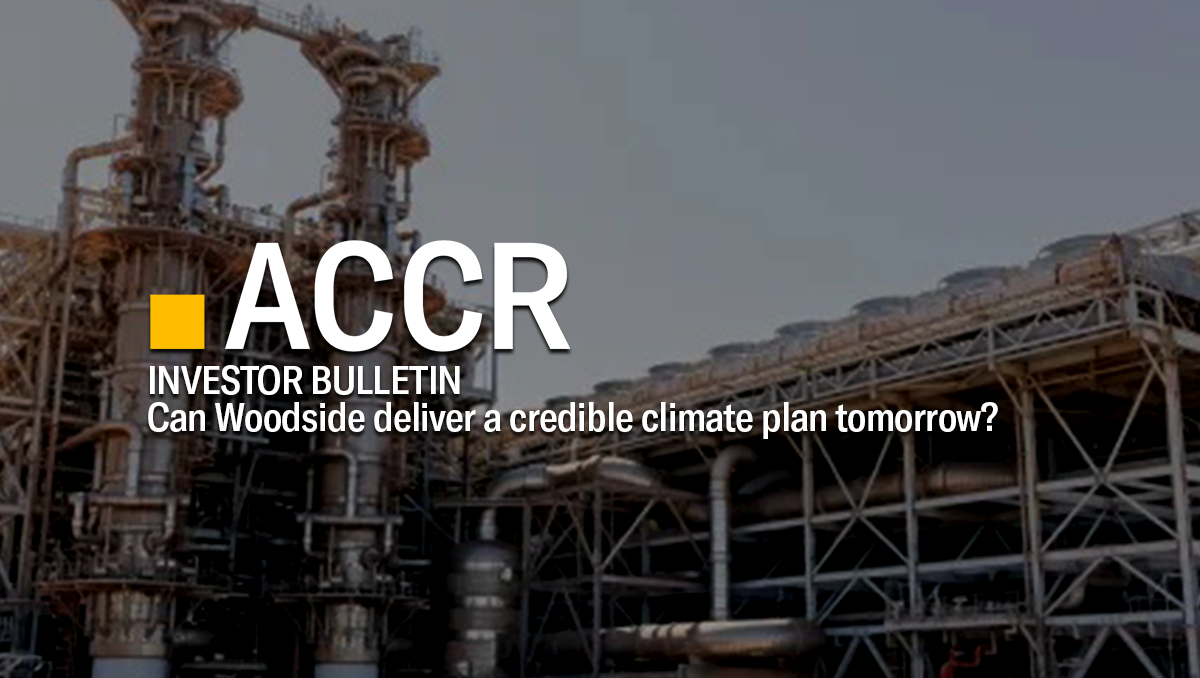Investor Insight Investor Bulletin: Can Woodside deliver a credible climate plan tomorrow?
Tomorrow, Tuesday 27 February 2024, Woodside will publish its 2023 Climate Plan. Coming nearly one year after the record-breaking[1] 35% vote against director Ian Macfarlane due to investor concerns over climate governance, this is a crucial opportunity for the board and Chair Richard Goyder to demonstrate they have the ability to listen to investor feedback
The 2023 Climate Plan will be put to a vote at the 2024 AGM, the result of a last minute concession[2] from the board prior to last year’s AGM.
Our assessment is that a large gap exists between Woodside’s current company strategy and its ability to assure investors the board is capable of managing climate risk and maximising shareholder value in the face of the global energy transition.
Based primarily upon the presentations at the 2023 Investor Briefing Day, the major barriers we see are:
- Oil and gas expansion remains Woodside's priority: Having not sanctioned a significant ‘new energy’ project to date, all of Woodside’s sanctioned capex has been allocated to oil and gas expansion. When adding Browse, Calypso, Sunrise and Woodside’s $5bn ‘new energy’ capex target, ACCR estimates that 88% of greenfields capex is still targeting fossil fuels.[3]
- Operational emission targets (8% of emissions) are unlikely to be credibly strengthened: With Scarborough, Sangomar and Trion coming online before 2030, scope 1 emissions are expected to increase, meaning the probability of Woodside credibly strengthening its operational targets is low.
- A credible Scope 3 target (92% emissions) is not possible: Already, over 90% of Woodside’s emissions are Scope 3 emissions. With an additional 475 MtCO2e coming from projects the company is actively developing, we see no pathway for a credible Scope 3 target to be announced by the company without a change in company strategy.
- Offsets will remain integral to meeting operational targets: Despite a growing emphasis on unsanctioned and ‘indicative’ scope 1 reductions that cost up to US$500 /tCO2e, Woodside has not disclosed the potential emissions increases associated with the oil, gas and hydrogen projects it is pursuing. ACCR estimates that scope 1 emissions from Browse, Calypso and Sunrise will be 80 MtCO2e. This exceeds the upper estimates of Woodside’s potential scope 1 emission reductions. With potential new emissions exceeding potential reductions, offsets will inevitably remain a key lever for Woodside to claim it is decarbonising its operations.
As a reminder, previous ACCR analysis concluded that Woodside's oil and gas growth opportunities deliver less value than a share buyback would. Any board that is sincerely looking to manage climate risk and maximise shareholder value should be considering all options before it.
Please read the terms and conditions attached to the use of this site.
Download Woodside’s 2023 Climate Plan Preview | 26/02/24
https://www.accr.org.au/news/woodside-pays-for-climate-failings-with-record-breaking-vote-against-director/ ↩︎
https://www.afr.com/companies/energy/woodside-yields-on-climate-vote-but-resistance-remains-20230417-p5d13y ↩︎
Derived from https://www.accr.org.au/downloads/wds_growthportfolio_20230821.pdf ↩︎
